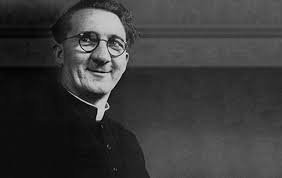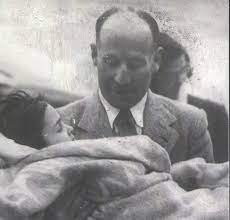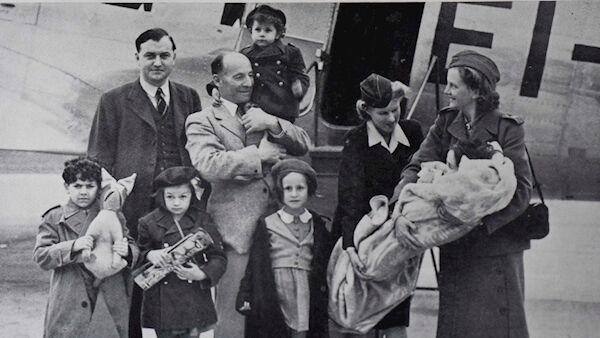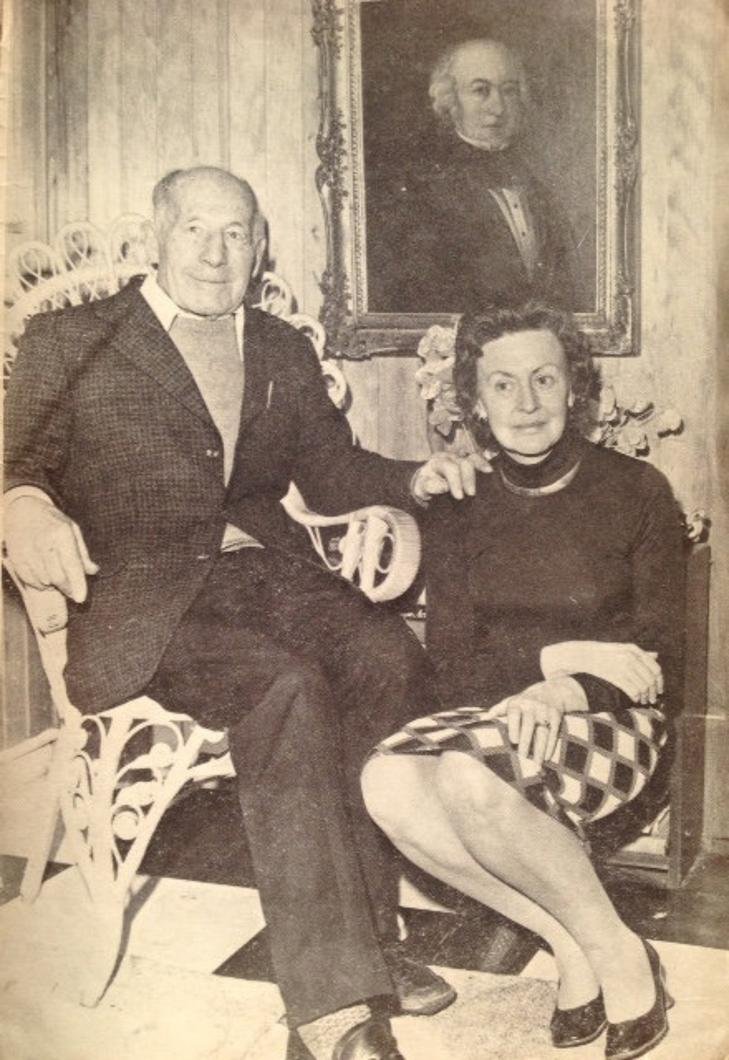Bob Collis
Dr Collis volunteered with the British Red Cross immediately after the war and tended to hundreds of young children who had survived Bergen-Belsen. Bob and Han Collis brought six children back with them to Ireland.
Joining the Red Cross
As volunteers with the British Red Cross immediately after the war, Bob Collis and Han Hogerzeil tended to hundreds of young children who had survived Bergen-Belsen. They brought six of these children back with them to Ireland.
Towards the end of the war, Dr Bob Collis, a paediatrician at Dublin’s Rotunda Hospital, joined the British Red Cross and St John’s Ambulance Brigade together with Irish medical colleagues Patrick MacClancy and Nigel Kinnear. Their goal was to reach continental Europe and give service to war victims. When they heard eyewitness accounts about the conditions in Bergen-Belsen, Bob Collis and his colleagues immediately volunteered their help. They were joined by a Dutchwoman, Han Hogerzeil, a lawyer who spoke five languages and who, together with her mother, had helped to run a safe house for Jews during the war. Han’s family lost everything, including the family home, at the Battle of Arnhem.
When British forces liberated Bergen-Belsen on 15 April 1945, they found more than 50,000 human beings alive under appalling conditions. The stench of death could be detected from 15 miles away.
Belsen itself was not an extermination centre but had originally been intended as a POW and a transit camp. Inmates perished in their thousands from starvation and disease. Their malnutrition was exacerbated by an epidemic of typhoid fever, carried by lice, and which spread like wildfire. 14,000 prisoners died in the first few days after liberation, and similar numbers perished in the following weeks.
One of the blocks that Bob took on in the camp contained over five hundred orphan children recovering from malnutrition. Another block was transformed into a children’s hospital. Han’s knowledge of languages was invaluable; the children were of nine different nationalities.
Han Hogerzeil (centre – 3rd from left) and Bob Collis (4th from Left) at Belsen
(image courtesy of Belsen.co.uk online archive)
The following is an extract from Straight On, a 1947 memoir written by Bob Collis and Han Hogerzeil.
Now commenced perhaps the most extraordinary liberation in the history of the world. The British troops who first came in were chiefly hygiene men. They started at once the Augean task of cleaning up the place. For the first two days they were almost alone and had to leave the SS guards around to prevent the typhus patients from getting out and starting an epidemic. Then more troops arrived, and the now famous 32 Casualty Clearing Station came in under Lieut-Colonel Johnston, who took over the medical command.
The SS were rapidly got under control. The enraged British private soldiers who saw the pitiable corpses and the more pitiable sick, starved and dying, turned with rage and contempt on the murderers, and beat them up. They made them bury the dead at the double. They fed them on the rations the SS had given their prisoners.
Then gradually the English rage subsided. Staff officers removed the remaining SS men for imprisonment and questioning. Some of these were already incubating typhus, caught from lice when burying the dead. When the fever came out they were not treated as patients but rather as they had treated others heretofore.
Bergen-Belsen on the day of its liberation by British troops.
Image courtesy: Imperial War Museum.
The children of Bergen-Belsen
Six of the children in the hospital – Zoltan and Edit Zinn, Tibor (Terry) and Suszi (Suzi) Molnar, Evelyn Schwarz and Franz Berlin – became Bob’s ‘special charges’. Zoltan and Edit Zinn were of Slovak origin. Two of their siblings had not survived – their baby sister died in the cattle car on the way to the camps, and their brother, Aladar, died immediately after liberation, as did their mother. Bob and Han managed to nurse Zoltan through tubercular pleurisy and critical complications.
Tibor and Suszi Molnar came from a cultured Jewish-Hungarian background. All of their family had been murdered by the Nazis and their mother, Gisella, died in Belsen immediately after liberation. Evelyn Schwartz was a little German-Jewish girl, and Franz Berlin was so called because he had been picked up unconscious in the street in Berlin and brought to the hospital in Belsen.
After many of the children in the camp had been restored to health, they were repatriated to their different countries. The Swedish government invited hundreds of the remaining orphans to Sweden, where they could recuperate further. Since nobody appeared to claim ‘Bob’s children’, he eventually brought them home to Ireland. They stayed in Fairy Hill, a beautiful open-air hospital on the Hill of Howth near Dublin for some months for further convalescence. Bob and his wife made Zoltan and Edit part of their own family and the children added ‘Collis’ to their own names. Bob arranged the first formal adoption in Ireland when he organized for Tibor (Terry) and Suzi Molnar to be adopted by a Dublin Jewish couple, Willie and Elsie Samuels. Evelyn Schwartz was also adopted by a Dublin couple who later moved to Australia.
Dr Bob Collis with a group of child refugees arriving in Ireland, pictured holding Suzi Diamond.
Dr Bob Collis with one of the Belsen children, Zoltan Zinn-Collis, at Fairy Hill, Co, Dublin.
Later life
Han went on to a distinguished humanitarian career in refugee resettlement work. She served at the United Nations Headquarters in New York, and later at the InterGovernmental Commission for Refugees in London. She later studied medicine at King’s College Hospital in London, and did her internship at the Jewish Hospital in the East End of London.
Bob and Han eventually married. They were two matched spirits who met through the hell of Belsen and devoted their entire lives to the well-being of children of all religions and cultures. They later worked with Han’s brother, Dr Lykle Hogerzeil, at his leprosy mission in India. Wherever they worked and lived, they stayed in touch with their ‘Belsen children’ who all thrived, and whose children and grandchildren can be found throughout the world.
Dr Bob Collis with Han Hogerzeil
Learn about other heroic Irish people
-

Mary Elmes
-

Hubert Butler
-

Msgr O'Flaherty






